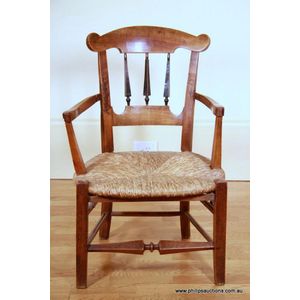French Yoke Back Rush Chair, Late 19th Century
A French provincial elm and Rush chair, late 19th century, having a distinctive yoke back with extended side ears, spear form spindles to the midrail, tapering arm rests and conforming side supports to the rush seat, with square form legs united by a box stretcher, the front stretcher of double spear form. Height 83 cm
You must be a subscriber, and be logged in to view price and dealer details.
Subscribe Now to view actual auction price for this item
When you subscribe, you have the option of setting the currency in which to display prices to $Au, $US, $NZ or Stg.
This item has been sold, and the description, image and price are for reference purposes only.
- Stretcher - A horizontal rail which connects the legs of stools, chairs, tables and stands, to provide stabilisation of the legs. A stretcher table is any table with a stretcher base. The term is usually applied to substantial farmhouse tables, although many cabinetmaker's pieces, such as sofa tables, also have turned stretchers.
- Rush Seating - Associated with country style chairs, stools and settees, rush seats are woven from rushes, with the pattern of the weaving often dividing the the chair seat diagonally into four triangles.
The weaving of rushes has been practiced for centuries, and it is believed that some early rush seats of the 18th and 19th century were painted, although common practice now is to leave the rush in its natural state. As the rush ages the colour
Rushes of the type used in Europe for seating are not available in Australia, and instead fibre rush, a man-made product from one-ply twisted paper, is used. Another substitute material is twisted natural sea grass.
Seats in Danish furniture of the 1950s were often finished with Danish cord, a three ply twisted paper cord, which has a similar appearance to rush. - Spindles - Short turned pieces, used as stretchers or back supports mainly in cottage chairs, couches and day beds. Turned shelf supports and the railings used in the backs and arms of day beds during the late 19th century are also referred to as spindles. Until the coming of the industrial age, spindles, like all turned pieces, were made by hand, and should show some slight variation. With the introduction of the factory lathe, spindles and turned legs became quite uniform and standard.
This item has been included into following indexes:
-
chairs, singles / pairs / threes, style or period
- armchairs 1,769
- elm 239
- French 966
- rush-seated 115
- Victorian, other styles 1,220
Visually similar items

A pair of low French armchairs, each with a floral carved splat and a rattan seat. Provenance: The Kurt Albrecht collection.
Sold by
in
for
You can display prices in $Au, $US, $NZ or Stg.

Chippendale style mahogany elbow chair 19th century, maroon leather upholstery and stud work, height 93 cm
Sold by
in
for
You can display prices in $Au, $US, $NZ or Stg.

Georgian style mahogany elbow chair 19th century or earlier
Sold by
in
for
You can display prices in $Au, $US, $NZ or Stg.

An Australian carver chair, solid blackwood, early 20th century, 60 cm across the arms
Sold by
in
for
You can display prices in $Au, $US, $NZ or Stg.
